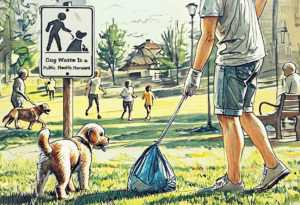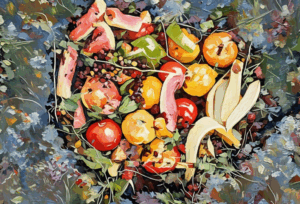
When you think of the word “agriculture”, you’d probably expect farms, animals, food, and nature. And when you think of these things you would assume they all would have positive effects on our environment, however in recent years, some of agriculture’s most centralized topics have been eroding our environment. Farms, a pretty major aspect of agriculture, are the source of environmental issues like climate change, pollution, soil degradation and deforestation. In contrast, another aspect of agriculture, farm animals, are working to put an end to the environmental drawbacks farms cause.
Farm animals play a vital role in both the environmental and agricultural worlds. They’re kind of like our environmental superheroes from behind the scenes. Ranging from miniature horses, to buffalo, to cows, farm animals have a primary role in not only our daily lives but also our ecosystem and environment.
Farm animals play a special role in our economy and agriculture because they help produce products such as wool and milk, and they improve the quality of soil on farms. Agriculture may seem to be based on crops, but crops actually need the help of animals to thrive. Animals provide sustainable soils for crops(through manure & compost). And in modern-times of climate change, where soil can get easily dehydrated and malnourished, healthy soil is vastly important. (Reynolds). From this healthy soil, farmers grow healthy crops which we eat and use on a daily basis. Survival for humanity starts with the bond between animals and nature. You probably don’t track how many animal products you use a day, but in a single day the average person can use hundreds of animal-based products.
Let’s start with breakfast. Bacon and eggs, milk, or maybe yogurt. All these products were produced from farm animals. Meat, crops, dairy, and various other products all come from farms (basically all our groceries and food, even clothing items!). Farm animals have always been needed for survival even during developing times in history. This fact hits especially hard in recent times as farms are being put under the pressure of our whole world due to increasing populations and environmental hardships. To put this to scale, by 2050 farms will have to produce more than 200 million tons per year in addition to what they already produce(350 million tons) to keep up with population increase (FB). The production of all this excess food is going to be produced by farm animals.
So who are the “villians” that our superhero league of farm animals is fighting? That would in fact be the very farms they live on. We can call them, “Non-Sustainable Farms”. Non-Sustainable Farms refers to the practice of environmentally-damaging farming. Non-sustainable farming can ruin nearby environment’s that are already going through global complications such as climate change.
Climate change is a notable villain of farms that not even farm-animals can fight against. Temperatures can reach over 100 degrees, which threatens the health and well-being of crops, farmers, workers, and farm animals. Farm animals are specifically threatened by rising temperatures and require additional care when temperatures start to rise including high water costs, fans, shade stables(sheds placed in paddocks for shade), and regular baths due to increased sweat production. If animals do not receive this care because farmers refuse to pay or put time into it, farm animals will be put in danger and the benefits of farm animals will be reduced as well which results in extreme environmental hardships. Climate change is clouding the success of all farm’s around the world.
However, the mastermind behind greenhouse gas emissions that are the source of climate change are in fact farms themselves(specifically, non-sustainable farms). Farming has been negatively impacting our lands since as early as 7-8,000 years ago. Though recently, the gas production caused by new farming technologies has been wreaking havoc on our atmosphere. (Dupuis). Farms are responsible for 10.6% of our world’s greenhouse gas emissions, while this may be low compared to other sectors on the scale this could cover a whole country in greenhouse gas. (U.S Department of Agriculture). Farming is also shown to degrade and erode topsoil, the very thing that farm animals work to improve. (National Family Farm Coalition).
Even with all the negatives that farming can produce, farm animals have ways of canceling them out. But the positive effects of farm animals can only truly be seen when the farmer wishes to improve the environment as well. As farming continues to harm our environment, new environmentally-friendly sciences and pieces of technology have allowed for agriculture to become sustainable with simple changes. Most of these changes start with implementing the products of farm animals into everyday farming. These changes can all be labeled under a type of farming called, Sustainable Farming. It is so important to advertise the benefits of sustainable farming and positive animal care because while farms are a leading cause of so many environmental concerns, they are not something we can remove from our world without any consequences. Sustainable farming utilizes nature in a way that helps it grow even further.
Sustainable farming is key to a healthy environment, and it utilizes our superhero animals. Sustainable farming is a way of farming that is environmentally-friendly and tries to prevent further environmental damage caused by agriculture. Sustainable farming can be identified by farming in a way that helps the environment such as, utilizing compost, rotating crops(for soil health), supporting and caring for livestock(animals), using natural plant protectants, and investing in new agricultural sciences. (National Family Farm Coalition). When farms are sustainably run, all aspects of nature thrive as sustainable-farming focuses more on supporting the environment as a “friend” rather than seeing it as a resource or a way to make profit. By this I mean that farms rotate crops, buy specific environmentally friendly technology, give their animals the best possible care, and even test their soil and water weekly. All of this effort ensures the happiness of both farm owners and our environment.
The success of sustainable agriculture mainly comes from the effort of farm animals. Farm animals aid crop biodiversity(by eating weeds), compost production, world-wide C02 increases (by chemical reactions caused by eating grass), and soil nutrition. (Union of Concerned Scientists) And with the support of farm animals and nature, sustainable farms produce an even larger number of products than normal farms, and their products are healthier for both consumers and the environment. Sustainable farming is more of a modernized idea and as most farms run on practices that have been tested for hundreds to thousands of years, most farms have neither the time nor money(new technology is more expensive than traditional equipment) to change their traditional ways.
Even without the major chaos of climate change, farms have been fighting a heavy battle between mass-consumerism and the economy. Introduction like artificial foods, mass-produced products, commercially produced products, and pre-packaged foods all damage the agricultural world. Society now has to choose whether they are fully artificial or natural. Support local, sustainable farms because without that single mini horse in your local community, your local ecosystem might turn downhill.
Works Cited
Dupuis, Allison. “Environmental Impact of Traditional Farming: 5 Effects.” Eden Green, 12 June 2024, https://www.edengreen.com/blog-collection/environmental-impact-of-traditional-and-vertical-farming-2021-report. Accessed 24 August 2024.
FB. “Fast Facts About Agriculture & Food.” American Farm Bureau Federation, https://www.fb.org/newsroom/fast-facts. Accessed 26 August 2024.
National Family Farm Coalition. “Farmers and the Environment.” National Family Farm Coalition, https://nffc.net/what-we-do/farmers-and-the-environment/. Accessed 16 August 2024.
Reynolds, Lawrence P., et al. “Importance of Animals in Agricultural Sustainability and Food Security.” NCBI, 13 May 2015, https://www.ncbi.nlm.nih.gov/pmc/articles/PMC6625004/. Accessed 16 August 2024.
Union of Concerned Scientists. “What is Sustainable Agriculture?” Union of Concerned Scientists, 10 April 2017, https://www.ucsusa.org/resources/what-sustainable-agriculture. Accessed 24 August 2024.
U.S. Department of Agriculture. “Chart Detail.” USDA ERS – Chart Detail, 14 February 2024, https://www.ers.usda.gov/data-products/chart-gallery/gallery/chart-detail/?chartId=108623. Accessed 16 August 2024.
The views and opinions expressed are those of the authors and do not necessarily reflect nor represent the Earth Chronicles and its editorial board.




